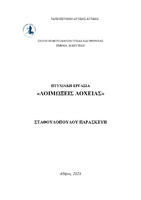| dc.contributor.advisor | Νάνου, Χριστίνα | |
| dc.contributor.author | Σταθουλοπούλου, Παρασκευή | |
| dc.date.accessioned | 2021-11-02T10:10:40Z | |
| dc.date.available | 2021-11-02T10:10:40Z | |
| dc.date.issued | 2021-06-28 | |
| dc.identifier.uri | https://polynoe.lib.uniwa.gr/xmlui/handle/11400/1466 | |
| dc.identifier.uri | http://dx.doi.org/10.26265/polynoe-1317 | |
| dc.description.abstract | Εισαγωγή: Οι λοιμώξεις της λοχείας αποτελούν την πιο συχνή επιπλοκή μετά τον τοκετό.
Επίσης σχετίζονται με παρατεταμένο χρόνο νοσηλείας αλλά και αυξημένο κόστος φροντίδας.
Σκοπός: Είναι η ανασκόπιση των λοιμώξεων που εμφανίζονται, μετά τον τοκετό, κατά τη
διάρκεια της λοχείας και συγκεκριμένα της μαστίτιδας, της ενδομητρίτιδας και της ουρολοίμωξης, η
διάγνωση και η αντιμετώπιση της κάθε μίας από αυτές τις παθήσεις από τους παρόχους φροντίδας
υγείας.
Μέθοδος: Έγινε βιβλιογραφική αναζήτηση στο Pubmed για χρονικό περιθώριο αναζήτησης
από 5έως 10 έτη. Κριτήρια αποκλεισμού ήταν η εκτός θέματος αναφορά, ο μικρός όγκος πληθυσμού
αλλά και η αναφορά σε ζώα.
Αποτελέσματα: Σαν αποτελέσματα φάνηκαν για την μαστίτιδα ότι διορθωτικές κινήσεις στην
θηλή δεν μειώνουν τις επιπλοκές κατά τον θηλασμό. Στην αντιβιοτική αγωγή για την μαστίτιδα δεν
αποτρέπεται ο θηλασμός. Η προφυλακτική χρήση κολπικού διαλύματος ή η αντιβιοτική χορήγηση
μετά τον τοκετό φάνηκε να μειώνει τον κίνδυνο για ενδομητρίτιδα μετά τον τοκετό. Σε γυναίκες που
θηλάζουν η αντιβιοτική αγωγή φάνηκε να μην δημιουργεί προβλήματα, εφόσον ενδείκνυται η αγωγή
αυτή στον θηλασμό. Στην ουρολοίμωξη δεν υπήρχε ολοκληρωμένη άποψη για τον διακοπτόμενο
καθετηριασμό σε σύγκριση με τον συνεχή, λόγω μικρού όγκου άρθρων.
Συμπεράσματα: Στην μαστίτιδα δεν υπάρχει κάποιο επιστημονικό δεδομένο που να προτείνει
την χρήση αντλίας για την βελτίωση του θηλασμού. Η χορήγηση ντοπεριδίνης και μετοχλωραμίδης δεν
ενδείκνυται κατά την διάρκεια της γαλακτοφορίας. Σε ραγδαία αύξηση του μαστού σε πρώιμο στάδιο
λοχείας προτείνεται η χρήση gel προγεστερόνης τη 3η με 4η μέρα μετά τον τοκετό προληπτικά. Στην
ενδομητρίτιδα η χορήγηση γενταμυκίνης και κλινδαμυκίνης μειώνει τον κίνδυνο λοίμωξης μετά τον
τοκετό, και η αποτελεσματικότητα της πρέπει να αξιολογείται 48-72 h μετά την έναρξή της. Σε
περίπτωση που η λοίμωξη παραμένει, γίνεται χορήγηση μετρονιδαζόλης. Η από τους στόματος αγωγή
δεν χρειάζεται να συνεχίζεται όταν η ενδοφλέβια χορήγηση έχει επιφέρει κλινική βελτίωση. Επίσης το
κολπικό διάλυμα ποβιδίνης- ιώδιο ή χλωρεξιδίνης φάνηκε να μειώνει τον κίνδυνο για ενδομητρίτιδα
μετά τον τοκετό όταν χορηγείται προληπτικά. Στην ουρολοίμωξη δεν υπήρχαν σαφείς διαφορές στις
γυναίκες με διακοπτόμενο καθετηριασμό σε σύγκριση με εκείνες που είχαν συνεχή όσο αναφορά για
λοιμώξεις του ουροποιητικού συστήματος, κατακράτηση ούρων και αιμορραγία αλλά το εύρος των
μελετών ήταν πολύ μικρό. | el |
| dc.format.extent | 38 | el |
| dc.language.iso | el | el |
| dc.publisher | Πανεπιστήμιο Δυτικής Αττικής | el |
| dc.rights | Αναφορά Δημιουργού - Μη Εμπορική Χρήση - Παρόμοια Διανομή 4.0 Διεθνές | * |
| dc.rights | Attribution-NonCommercial-NoDerivatives 4.0 Διεθνές | * |
| dc.rights.uri | http://creativecommons.org/licenses/by-nc-nd/4.0/ | * |
| dc.subject | Λοχεία | el |
| dc.subject | Μαστίτιδα | el |
| dc.subject | Ενδομητρίτιδα | el |
| dc.subject | Ουρολοιμώξεις | el |
| dc.subject | Λοιμώξεις Λοχείας | el |
| dc.subject | Ουρολοιμώξεις στη Λοχεία | el |
| dc.subject | Postpartum | el |
| dc.subject | Mastitis | el |
| dc.subject | Endometritis | el |
| dc.subject | Urinary tract infection | el |
| dc.subject | Puerperal infection | el |
| dc.subject | Postpartum urinary infection | el |
| dc.title | Λοιμώξεις Λοχείας | el |
| dc.title.alternative | Postpartum infections | el |
| dc.type | Πτυχιακή εργασία | |
| dc.contributor.committee | Vivilaki, Victoria | |
| dc.contributor.committee | SARANTAKI, ANTIGONI | |
| dc.contributor.faculty | Σχολή Επιστημών Υγείας & Πρόνοιας | el |
| dc.contributor.department | Τμήμα Μαιευτικής | el |
| dc.description.abstracttranslated | Introduction: The postpartum infections, constitute the most common complication after
childbirth. Moreover, they are related to prolonged period of hospitalization and increased healthcare
costs.
Aim: Is a systematic review of most infections that might occur following birth and the
postpartum period, specifically the mastitis, the endometritis and the urinary tract infections. Also, we
discuss, the diagnosis and the treatment protocols that are followed by health care professionals,
regarding these conditions.
Methods: Α thorough research was conducted, using Pubmed, with a time limit of 5-10 years.
The eliminating factors were the unrelated references, the small population volume and the references
regarding animals.
Results: Results referring to mastitis, indicate that nipple stimulation preparation techniques
do not alleviate the nipple complications. During antibiotic therapy for mastitis, breastfeeding is not
prohibited. The preemptive use of vaginal solution or antibiotics, seem to reduce the danger of
endometritis after birth. For women who breastfeed, the antibiotic therapy doesn’t appear to provoke
any problems, supposing that the specific treatment is allowed while breastfeeding. Regarding the
urinary tract infection, there was not a clear view about the intermittent catheterization compared to the
continuous one because of insufficient number of articles.
Conclusions: There is no scientific evidence which suggests using a breast pump, for the
improvement of breastfeeding, for patients with mastitis. Treatment with domperidone and
metoclopramide is not allowed during lactation. An upsurge in breast size in the early postnatal period
suggests the preemptive use of progesterone gel on the 3rd-4th day after birth. In endometritis, the use
of gentamicin and clidamycin, alleviates the danger of infection after birth and the effectiveness of the
treatment must be evaluated within 48-70 hours. In case that the infection is not contained, the using of
metronidazole is needed. Oral treatment can be stopped if intravenous administration causes
improvement. Also, the vaginal solution of povidone-iodine or chlorhexidine seems to reduce the
danger for endometritis after birth when the administration is done preemptively. As for the the urinary
tract infection, there were no clear differences between women with intermittent catheterization and
women who had abiding catheterization, regarding urinary tract infection, postpartum urinary retention
and postpartum hemorrhage, but the range of scientific studies was very small. | el |


